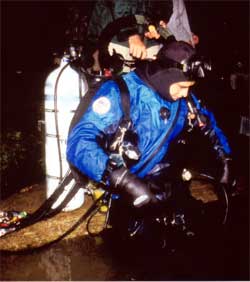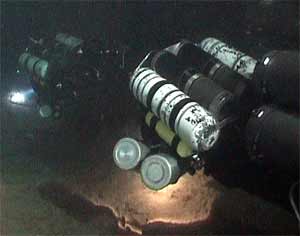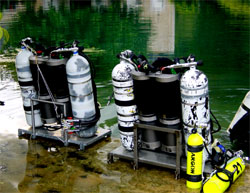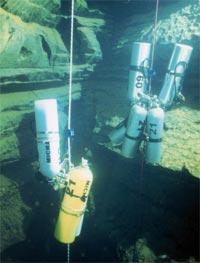Doux de Coly
| Doux de Coly By Michael Waldbrenner
The Doux de Coly is located in the Dordogne, in the middle of France, a country renown for its beautiful underwater caves. Although they are not as decorated as the caves in Mexico, nor as warm as the caves in Florida, the caves in France have their own "magic." The entrance to Doux de Coly is on private property and was first dived in the 1960s. However, it was not until 1970, when P.J. Debras reached a depth of 52 meters (170 feet) and a penetration of 365 meters (1,200 feet), that the shaft and deeper part of the cave were reached. In 1981, the Swiss Groupe Lemanique de Plonger Souterrain (GLPS) pushed the end of the line to 1,760 meters (5,774 feet) using DPVs; they then returned in 1983, to push it further to 2,100 meters (6,889 feet). The same year, Oliver Isler extended the line to 3,100 meters (10,170 feet) after a three-hour bottom time and eight hours of decompression. In 1991, Isler reached 4,055 meters (13,303 feet) in Doux de
Coly; his total in-water time was fourteen hours. The British Cave
Diving Group was also heavily involved in this expedition. Isler
returned in July of 1998 and reached At the beginning of 2001, Reinhard Buchaly suggested that we should check out the Doux de Coly using the RB80 rebreathers in a double configuration. The double configuration was used because setting up the deeper section of the cave with enough stages was not an option for us. The entire project was to be carried out in one week; however, a "spare week" was incorporated just in case. To help us carry out our plan, we solicited the assistance of other DIR divers in Europe. In the end, fourteen people from six different countries showed up to assist us. Support divers used Trimix 21/35 for setting up the habitats, for placing stages, heating tubes, etc. Training for setting up these habitats was done in a local quarry a few weeks before the project. The water temperature in Doux de Coly is 12° C (54° F) all year round. Because of this, we decided to use habitats and electrical heating during decompression. Though we could have survived without the latter, it would have been pretty unpleasant. The toughest part of it was hammering the spits that anchor the two habitats into the limestone. Due to the nature of the cave we had no other available option. For set-up, one team placed Trimix stages at 800 meters (2,640 feet) while another placed four Magnum scooters at 500 meters (1,650 feet). We were to pick these up during the push dive. The work was both fun and a great learning experience for everyone involved. On the morning of August 9, 2001, we took off at 06:41 in the morning. We wanted to start early, in the cool morning hours, to avoid sweating too much during gearing up. We did not want to chance becoming cold later on in the dive. At the shaft, we left the stages containing Trimix 50/25 and picked up stages containing Trimix 19/65 to drive the rebreathers. Our next stop was planned for around 500 meters (1,600 feet) where we were to pick up the four scooters; later at 800 meters (2,640 feet) we were to pick up two Trimix stages each, one with 19/65 and the other with 30/50. Here we also left the stages we had used up to this point as well as a 14 cubic foot Argon tank that we had used to inflate during the initial descent. The last thing you want to happen during a dive like this is to run out of Argon. From time to time we swapped rebreathers to check if they were working properly. Reinhard´s plan was to breathe down his units equally while I decided to check how long one scrubber would last during these conditions. Reinhard and I were each carrying four Magnum scooters, each one
with more than two hours of burn time, and one 20 amp-hour
NiCad-canister with an 18W HID-bulb. Ideally this would give us
more than nine hours Before the dive we had decided that we would call the dive if either one of us would lose one rebreather or more than one scooter. 131 minutes into the dive we found ourselves shallower than 50 meters (164 feet); at 160 we were forced to replace quite a bit of cave line, which took us quite a while. Directly after the line repair I caught the old line in my propeller, which completely jammed my scooter. We left one of my scooters at this point and agreed to continue. At 3,200 meters (10,500 feet) we each left one Trimix-stage behind and at 3,500 meters (11,480 feet) we clipped off two of Reinhard’s scooters and one of mine. We reached the end of Isler’s line at 221 minutes into the dive. We tied off and continued. Reinhard was laying line, while I took his backup scooter and lit him. Suddenly the cave started getting deeper again. Reinhard’s big exploration reel had 1,000 meters (3,300 feet) of 2.5-millimetre cave line on it; it was labelled in 20-meter increments to help measure distance. For this deeper part we decided to switch to our back gas for a bit, in the hope that the cave would become shallow again. When we reached an unexpected depth of 64.6 meters (213 feet) we decided to call the dive. We had put in an additional 700 meters (2,300 feet) of new line into the cave system, pushing the explored section of the cave now to 5,000 meters (16,400 feet). At this point, my Suunto Vyper showed 375 minutes. I pressed the marker button and we headed home. We picked up our scooters and stages, and at 80% of our maximum pressure we started our deep stops. We decided to do all our decompression on the rebreather units until we reached the habitat at 9 meters (30 feet), where we would switch to O2. All our decompression was done as if on open circuit so no extra
time was added The first support crew showed up shortly thereafter. Since we began the dive, teams had been scootering to the shaft every 30 minutes, where they looked for us, and went out again. I now wrote in the Wetnotes: "5 km everything OK." When this particular support team came out, we heard everyone start to cheer on the surface. We stayed in the tank for 8 minutes. The remained of the decompression we performed in a vertical shaft, which means, "being neutrally buoyant" at all times. The support team had installed two ropes in the shaft and had placed all our stages on mountaineering clamps. This allowed us to hang all our gear on the clamps and move it upwards. As we decompressed, we emptied our wings and put more Argon into ours suits in order to be warmer and more comfortable. The next crew arrived with the first warm tea. They asked us if everything was okay, and if we needed something. I answered "A Big Mac Meal" more as a joke that as a real request. We did gas breaks on open-circuit just to have another mouthpiece; by that time the inside of my lips were starting to hurt. We were already 557 minutes into the dive. During decompression, it was important for us to constantly check each other; especially when the support crew was away. After eleven hours on one Rebreather, I noticed that the scrubber was breaking through and switched to the other breather. As break gas we used standard deco-gases (35/35, 50/25) along with 17/55 and did a fifteen-minute cleanup break before hitting each pO2 of 1.6. At 21 meters (70 feet) we did fifteen minutes on deco-gas and five minutes on 17/55. Then our primary lights went out and we switched to the batteries of the heating canister. 730 minutes into the dive, we had to remove our rebreathers and
enter the habitat. We had practised this with some of the crew
before the dive. We put on a weight-belt, clipped some weight to
it, then grabbed the break gas and went into the habitat.
Initially, the habitat has very little air inside. Suddenly, a Big Mac Meal appeared; it was even warm! The closest McDonald’s was 30 kilometers away! Reinhard did not eat his, but I did, and laughed out loud about it. Reinhard read and I just looked out of the window most the time. We left all of the lights turned on so I could enjoy looking out of the window. Our support people did a great job. After our nine-meter (30 foot) decompression stop was over, we switched to 17/55 again and exited the cave. The support team had placed light sticks on the last few meters of the line, so it was like flying in with an airplane. In the entrance pool at 6 meters (20 feet) we stopped for a few minutes to see what the Suunto Vyper was doing at 999 minutes. After a few minutes we realized it must have stopped, so we ascended very slowly. After surfacing, we were showered with Champagne and told that the barbecue was ready. We stood in the water for a couple of minutes, while some of the team members put our gear near the water just in case we needed to go back in again. We both felt very well, so we exited the water and sat around for another hour. Then we checked ourselves with a Doppler, ate and talked to the team about the dive. When doing such a dive, one really notices how important it is to have standards for a team. It was helpful for us to have had the chance to do a dive with George Irvine and the WKPP in Wakulla two months before this dive. There we could see first-hand how a well-organized cave project is conducted. There is a good chance we will return to France this summer, bringing with us one more scooter, one more stage bottle (with deeper mix), to see where the Doux de Coly is going. Doux de Coly Team: Michael Waldbrenner and Dr. Reinhard Buchaly, with the support of: Christiane Wieland, Dirk Zielinski, Goetz Braetuigam, Harmen Nieuwenhuis, Helmut Pearson, Hervé Deschamps, Ian Pinkstone, John Grogan, Michael "Brus" Brusdeilins, Paolo Passalaqua, Peter Fjelsten, Ralph Wilhelm, Tanja Buchaly, Thomas Karch
|
Doux De Coly UPDATE: In August 2002 the European Karst Plain Project (EKPP) pushed the Doux de Coly cave system to a distance of 5,675 meters (18,618 feet) from air. The dive began at 7:03 am on 22 August 2002 and lasted 18 hours and 21 minutes. Exploration divers Michael Waldbrenner and Reinhard Buchaly surfaced on the morning of 23 August 2002 at 1:24 am after having added 675 meters (2,227 feet) of line and after having surveyed from their 5,000-meter (16,500 feet) end point of the last year. Each diver used a double RB80 rebreather configuration, with two 20 liter back mounted bailout cylinders (trimix 16/80), and five Magnum-Gavin-Scooters. As usual, the rebreathers performed flawlessly. For the most up to date information on the Doux De Coly
exploration check out: |
||||||||||||||||||||||||||||||||||||||||||||||||
|
Copyright © 2004 Global
Underwater Explorers. All rights reserved.
|
|||||||||||||||||||||||||||||||||||||||||||||||||


 4,300 meters (14,107 feet) during a three-week project that
involved 40 people. He was diving solo, using his RI2000 Rebreather
and Reinhard Buchaly´s Scooter.
4,300 meters (14,107 feet) during a three-week project that
involved 40 people. He was diving solo, using his RI2000 Rebreather
and Reinhard Buchaly´s Scooter. of
scooter power and around ten hours of light. The total scrubber
might last twenty hours, so we were well prepared. For backup light
we each had a 10W-HID slug in our pocket and double 20 Litre tanks
for bailout.
of
scooter power and around ten hours of light. The total scrubber
might last twenty hours, so we were well prepared. For backup light
we each had a 10W-HID slug in our pocket and double 20 Litre tanks
for bailout. for
being on rebreathers. Our first "real" stop was at 42 meters (138
feet) where we switched to Trimix 30/40 and we connected into the
electrical-heating tank.
for
being on rebreathers. Our first "real" stop was at 42 meters (138
feet) where we switched to Trimix 30/40 and we connected into the
electrical-heating tank. However, by lifting the seat with a rope and
exhaling, one quickly empties it of water, thus producing a dry
chamber that can accommodate one’s upper body. The habitat
had windows, so we could look around. In case the habitat broke
free, we kept our fins on and a mask near; the lead weights, still
attached, were next to us on the bench. We decided that we would do
a longer decompression than was needed in the habitat because the
next chamber was four-hours away by car and there was no helicopter
service at night.
However, by lifting the seat with a rope and
exhaling, one quickly empties it of water, thus producing a dry
chamber that can accommodate one’s upper body. The habitat
had windows, so we could look around. In case the habitat broke
free, we kept our fins on and a mask near; the lead weights, still
attached, were next to us on the bench. We decided that we would do
a longer decompression than was needed in the habitat because the
next chamber was four-hours away by car and there was no helicopter
service at night.